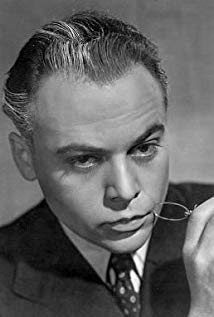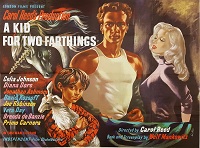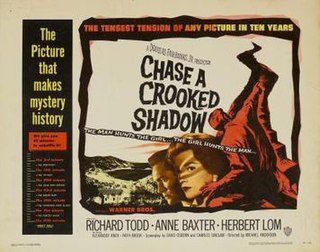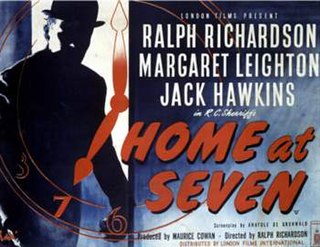
Glynis Margaret Payne Johns was a British actress. In a career spanning seven decades on stage and screen, Johns appeared in more than 60 films and 30 plays. She received various accolades throughout her career, including a Tony Award and a Drama Desk Award as well as nominations for an Academy Award, a Golden Globe Award, and a Laurence Olivier Award. She was one of the last surviving stars from the Golden Age of Hollywood and classical years of British cinema.

Douglas Elton Fairbanks Jr. was an American actor, producer, and decorated naval officer of World War II. He is best-known for starring in such films as The Prisoner of Zenda (1937), Gunga Din (1939), and The Corsican Brothers (1941). He was the son of Douglas Fairbanks and the stepson of Mary Pickford, and his first marriage was to actress Joan Crawford.

Herbert Charles Angelo Kuchačevič ze Schluderpacheru, known professionally as Herbert Lom, was a Czech-British actor with a career spanning over 60 years. His cool demeanour and precise, elegant elocution saw him cast as criminals or suave villains in his younger years, and professional men and nobles as he aged. Highly versatile, he also proved a skilled comic actor in The Pink Panther franchise, playing the beleaguered Chief Inspector Charles Dreyfus in seven films.

John Edward Hawkins, CBE was an English actor who worked on stage and in film from the 1930s until the 1970s. One of the most popular British film stars of the 1950s, he was known for his portrayal of military men.
Sidney Gilliat was an English film director, producer and writer.

Green for Danger is a 1946 British thriller film, based on the 1944 detective novel of the same name by Christianna Brand. It was directed by Sidney Gilliat and stars Sally Gray, Trevor Howard, Rosamund John, Leo Genn, and Alastair Sim. The film was shot at Pinewood Studios in England. The title is a reference to the colour-coding used on the gas canisters used by anaesthetists.

Hugh Anthony Glanmor Williams was a British actor and dramatist of Welsh descent.

Waterloo Road is a 1945 British film directed by Sidney Gilliat and starring John Mills, Stewart Granger, and Alastair Sim. It is based on the Waterloo area of South London. According to the British Film Institute database, it is the third in an "unofficial trilogy" by Gilliat, preceded by Millions Like Us (1943) and Two Thousand Women (1944).

A Kid For Two Farthings is a 1955 British comedy-drama film directed by Carol Reed. The screenplay was adapted by Wolf Mankowitz from his 1953 novel of the same name. The title is a reference to the traditional Passover song, "Chad Gadya", which begins "One little goat which my father bought for two zuzim". At the end of the film, Mr. Kandinsky softly sings fragments of an English translation of the song.

Only Two Can Play is a 1962 British comedy film directed by Sidney Gilliat starring Peter Sellers, Mai Zetterling and Virginia Maskell. The screenplay was by Bryan Forbes, based on the 1955 novel That Uncertain Feeling by Kingsley Amis.

British Lion Films is a film production and distribution company active under several forms since 1919. Originally known as British Lion Film Corporation Ltd, it entered receivership on 1 June 1954. From 29 January 1955 to 1976, the company was known as British Lion Films Ltd, and was a pure distribution company.

The Corsican Brothers is a 1941 American historical swashbuckler film directed by Gregory Ratoff and starring Douglas Fairbanks Jr. in a dual role as the titular conjoined twins who are separated at birth and raised in entirely different circumstances. Both thirst for revenge against the man who killed their parents, both fall in love with the same woman. The story is very loosely based on the 1844 novella Les frères Corses by French writer Alexandre Dumas, père.

The Man with Bogart's Face is a 1980 American comedy film, released by 20th Century Fox and based on a novel of the same title. Andrew J. Fenady, author of the novel, produced the film and wrote the screenplay.

Chase a Crooked Shadow is a 1958 British suspense film directed by Michael Anderson and starring Richard Todd, Anne Baxter and Herbert Lom. It was the first film produced by Associated Dragon Films, a business venture of Douglas Fairbanks Jr.

The Thief of Venice or Il Ladro di Venezia is a 1950 Italian film directed by John Brahm. The US title was "The Thief of Venice".

The Fighting O'Flynn is a 1949 American adventure film directed by Arthur Pierson. The film's screenplay by Douglas Fairbanks Jr. is based on the novel of the same name by Justin Huntly McCarthy. Fairbanks stars, along with Helena Carter.
Gordon Wong Wellesley was an Australian-born screenwriter and writer of Chinese descent. Born in Sydney in 1894 He wrote over thirty screenplays in the United States and Britain, often collaborating with the director Carol Reed. He began his career in Hollywood in the early 1930s and worked in Britain beginning about 1935. He was married to the scriptwriter Katherine Strueby. He was nominated for an Oscar for Best Writing, Original Story at the 1942 Oscars for Night Train to Munich, which was based on his novel, Report on a Fugitive.

The Beachcomber is a 1954 British comedy drama film directed by Muriel Box starring Donald Sinden, Glynis Johns, Robert Newton, Paul Rogers, Donald Pleasence and Michael Hordern. The film is based on the 1931 short story "The Vessel of Wrath" by W. Somerset Maugham and was adapted by Sydney Box. It was the second screen adaptation of the book following the 1938 film Vessel of Wrath. The film was shot at Pinewood Studios and on location in Ceylon. The film's sets were designed by the art director George Provis.

Home at Seven is a 1952 British mystery drama film directed by and starring Ralph Richardson, featuring Margaret Leighton, Jack Hawkins, Campbell Singer and Michael Shepley. It is based on the 1950 play Home at Seven by R. C. Sherriff. The film is Richardson's only work as director. Guy Hamilton was assistant director.
This is a summary of 1950 in music in the United Kingdom.
















